Frederick V of Nuremberg (before 3 March 1333 – 21 January 1398) was a Burgrave (Burggraf) of Nuremberg, of the House of Hohenzollern. He was the elder son of John II of Nuremberg and Elisabeth of Henneberg. From the death of his father in 1357, Frederick bore the title of Burgrave and so was responsible for the protection of the strategically significant imperial castle of Nuremberg. His zeal in the imperial cause led Charles IV to elevate him in 1363 to be the first Burgrave of royal rank.
Elisabeth of Meissen, Burgravine of Nuremberg (22 November 1329 – 21 April 1375) was the daughter of Frederick II, Margrave of Meissen and Mathilde of Bavaria and a member of the House of Wettin.
Frederick (1339 – 4 December 1393) was Duke of Bavaria from 1375. He was the second son of Stephen II and Elizabeth of Sicily.
Maddalena Visconti (1366 – 17 July 1404) was a daughter of Bernabò Visconti and his wife Beatrice Regina della Scala. Maddalena was Duchess of Bavaria-Landshut by her marriage to Frederick, Duke of Bavaria.
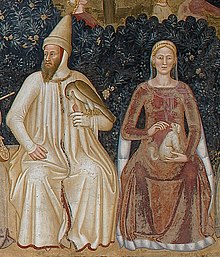
Henry of Brunswick-Lüneburg (Latin Henricus, died 14 October 1416), Duke of Brunswick-Lüneburg, called Henry the Mild, was prince of Lüneburg from 1388 to 1409 jointly with his brother Bernard I, Duke of Brunswick-Lüneburg, from 1400 to 1409 also of Wolfenbüttel, and from 1409 until his death sole prince of Lüneburg.
Henry was the fourth son of Magnus with the Necklace, Duke of Brunswick-Lüneburg. He participated in the prosecution of the murderers of his brother Frederick, elected King of the Romans, after 1400. Henry ravaged the Eichsfeld, a possession of thearchbishop of Mainz, who was suspected to be involved in the murder. Only in 1405, a peace was ratified between Brunswick-Lüneburg and the Archbishopric.
Enno Edzardisna (also known as Enno Cirksena, Enno Attena and Enno Syardsna; c. 1380 – c. 1450) was a chieftain of Norden,Greetsiel, Berum and Pilsum in East Frisia. He was the son of the chieftain Edzard II of Appingen-Greetsiel and his wife Doda tom Brok. Enno was a pioneer of the claim of the house Cirksena to the rule over all of East Frisia, which his son finally Ulrich I formally achieved when he was made an Imperial Count in 1464.
Gela Syardsna of Manslagt (d. 1455), a daughter of the chieftain Affo Beninga of Pilsum.
Uko Fockena (also known as: "Uko of Oldersum"; (c. 1408, Oldersum (uncertain) – 13 June 1432 near Suurhusen) was an East Frisian chieftain of Moormerland and Emsigerland. Uko was one of the sons of the East Frisian chieftain Focko Ukena (born: around 1370; died: 29 August 1436) and his wife Theda of Rheide (born c. 1365; died: before 1411).
Hebe (or Heba) of Dornum, a daughter of Lütet Attena of Dornum and Nesse and Ocka tom Brok, a daughter of Ocko I tom Brok.
Count Conrad V of Rietberg (died 31 October 1472) was Count of Rietberg from 1428 until his death. His father was Count Conrad IV of Rietberg.
Jacoba (d. 23 February 1492), a daughter of Count Gumprecht II of Neuenahr and Margaret of Limburg-Broich. T
Otto VII of Tecklenburg (died 1450) was Count of Tecklenburg from 1426 until his death. Otto VII was the son of the only son of Count Nicholas II of Tecklenburg and his wife Anna Elisabeth, a daughter of Count Frederick III of Moers. In 1426, he succeeded his father as Count of Tecklenburg. Like his father, he fought many feuds, in an attempt to win back some of the territories his father had lost. The attempt failed, and pushed his county deeper into debt. This accelerated the decline of the county.
Bernard II of Saxe-Lauenburg (German: Bernhard II.; ca. 1385/1392–16 July 1463) was a member of the House of Ascania and Duke of Saxe-Lauenburg from 1426 to 1463. His full title was Duke of Saxony, Angria and Westphalia, however only ruling the branch duchy of Saxe-Lauenburg between 1426 and 1463.
He was a son of Eric IV, Duke of Saxe-Lauenburg and Sophia of Brunswick-Lüneburg. Since long Bernard urged his ruling brotherEric V to share his reign. Failed in his fight for the Saxon electorate Eric finally agreed and made Bernard the co-duke of Saxe-Lauenburg in 1426.[1] When Eric V died in 1435 Bernard continued the reign alone.
Adelheid of Pomerania-Stolp (1410 – after 1445), daughter of Bogislaw VIII, Duke of Pomerania
Frederick II of Brandenburg (German: Friedrich II.) (19 November 1413 – 10 February 1471), nicknamed "the Iron" (der Eiserne) and sometimes "Irontooth" (Eisenzahn), was a Prince-elector of the Margraviate of Brandenburg from 1440 until his abdication in 1470, and was a member of the House of Hohenzollern.
Frederick II was born in Tangermünde to Frederick I, Brandenburg's first Hohenzollern ruler, and his wife Elizabeth, daughter of Frederick, Duke of Bavaria-Landshut, and Maddalena Visconti. The latter was a daughter of Bernabò Visconti and Beatrice della Scala. As the second son, his brothers included John the Alchemist and Albert Achilles, both of whom also ruled Brandenburg as margraves.

Catherine of Saxony (1421 – August 23, 1476), a daughter of Elector Frederick I of Saxony andKatharina of Brunswick-Lüneburg.
William (German: Wilhelm) called William the Younger (German: Wilhelm der Jüngere, c. 1425 – 7 July 1503) was duke ofBrunswick-Lüneburg and ruled over the Wolfenbüttel and Göttingen principalities.
The eldest son of William the Victorious, Duke of Brunswick-Lüneburg, he was given the Principality of Göttingen by his father in 1473. In 1482 the father died, and he and his brother Frederick succeeded their father in the remaining parts of his state; however, William had Frederick imprisoned in 1484 and made himself sole ruler. In 1490 he bought the City of Helmstedt from the Abbott ofWerden. In 1491, William gave the Principality of Wolfenbüttel including Calenberg to his sons, and kept only Göttingen to himself. In 1495 he resigned as prince of Göttingen in favour of his son Eric I in return for an appanage. William died on 7 July 1503 inHardegsen.
Eric II or Erich II (between 1418 and 1425 – 5 July 1474) was a member of the House of Pomerania (also known as the House of Griffins) and was the ruling Duke of Duke of Pomerania-Wolgast from 1457 to 1474. He was the son of Wartislaw IX of Pomerania-Wolgast and Sophia, daughter of Eric IV of Saxe-Lauenburg.

Sophia of Pomerania-Stolp (1435 – 24 August 1497), was a Duchess of Pomerania by birth, and married to Eric II, Duke of Pomerania.
Sophia was the daughter of Bogislaw IX, Duke of Pomerania and Maria of Masovia. In 1446, her father died and was succeeded by his cousin, Eric of Pomerania, former King of Denmark, Norway and Sweden. Sophia became the heir of Eric of Pomerania's private fortune. In 1451, Sophia was married to Eric of Pomerania-Wolgast, making her spouse the heir of Eric of Pomerania's territories, while Sophia remained the heir of Eric of Pomerania's private fortune. At the death of Eric of Pomerania in 1459, Sophia's husband united Pomerania through the inheritance of Pomerania-Stolp and Pomerania-Rügenwalde by his marriage, while Sophia became the sole possessor of the vast fortune brought by Eric of Pomerania from his former kingdoms's in Scandinavia, as well as the one he had acquired by his piracy activity on Gotland.
Christian V, Count of Oldenburg (sometimes called Christian VI; c. 1342 – after 6 April 1399) was the ruling count of Oldenburgfrom 1368 until 1398. He was born sometime before 1347 to Count Conrad I of Oldenburg and Ingeborg of Brunswick. After his father died in 1368, he ruled Oldenburg jointly with his elder brother Conrad II, and after Conrad II's deaths in 1386, with the latter's son, Maurice II.
Gerhard VI (c. 1367–1404) was the Count of Holstein-Rendsburg from 1382, and Duke of Schleswig as of 1386.
Gerhard VI was born around 1367, the son of Count Henry II from the Rendsburg line of the House of Schauenburg and Ingeborg of Mecklenburg. After the death, in 1381 or 1384, of his father, who had ruled jointly with Gerhard's uncle Nicholas (Claus), Gerhard and his younger brother Albert II entered into the joint government for their late father. On 15 September 1386 King Olav III of Denmark enfeoffed him with the Duchy of Schleswig, after his uncle Nicholas had resigned from that function.
Catherine Elisabeth of Brunswick-Lüneburg (1385 – after 1423) was Duchess consort of Schleswig and Countess consort of Holstein-Rendsburg. She was the regent of some of the fiefs of her son Henry during his minority from 1404 to 1415.
She was a daughter of Magnus II, Duke of Brunswick-Lüneburg and Catherine of Anhalt-Bernburg, daughter of Bernhard III, Prince of Anhalt-Bernburg. Through her mother, she was the great-great granddaughter of King Abel of Denmark. She would also become the grandmother of Christian I of Denmark.
Nicholas II of Tecklenburg († 1426) was the ruling Count of Tecklenburg from 1388 until his death. Nicholas II was the only son of Count Otto VI and his wife, Adelaide of Lippe, a daughter of Bernard V, Lord of Lippe.
Anna Elisabeth of Moers (d. 1430), a daughter of Frederick III, Count of Moers
Eric I, Count of Hoya (1370-1426) was a German nobleman. He was the ruling Count of Upper Hoya from 1377 until his death. Eric was the son of Count John II and his wife Helen, a daughter of Duke Eric I of Saxe-Lauenburg. His brother, John was Bishop ofPaderborn from 1394 to 1399 and Bishop of Hildesheim from 1399 to 1424. His brother Otto was Bishop of Münster from 1392 to 1424, and from 1410 to 1424 also administrator of Osnabrück
Helen, a daughter of Duke Magnus II Torquatus of Brunswick-Lüneburg

Albert II (Albrecht II) Duke of Mecklenburg (c. 1318 – 18 February 1379) was a feudal lord in Northern Germany on the shores of the Baltic Sea. He reigned as the head of the House of Mecklenburg. His princely seat was located in Schwerin beginning in the 1350s.
Albert was born in Schwerin as the second (but eldest surviving) son of Lord Henry II of Mecklenburg (c. 1266-1329), Lord of Stargard (Stari Gard), of the old Vendic princely clan of the Obotrites, and his second wife Princess Anna of Saxe-Wittenberg (d. 1327), of the princely Ascanian House.

Euphemia of Sweden (Swedish: Eufemia Eriksdotter; 1317 – 16 June 1370) was a Swedish princess, spouse of Albert II, Duke of Mecklenburg, Duchess consort of Mecklenburg, heiress of Sweden and of Norway, and mother of King Albert of Sweden.
Euphemia was born in 1317 to Eric of Sweden (b. c. 1282, murdered 1318), Duke of Södermanland, second son of King Magnus I of Sweden, and Princess Ingeborg of Norway (1301 – c. 1360), the heiress and the only legitimate daughter of King Haakon V of Norway, whose hereditary Kingdom of Norway thus became the inheritance of Euphemia and her brothers.
Barnim IV of Pomerania (1325 – 22 August 1365) was a Duke of Pomerania-Wolgast-Rügen He was the second son of Duke WartislawIV of Pomerania-Wolgast and the brother of Bogislaw V and Wartislaw V.
Eric II of Saxe-Lauenburg (1318/1320 – 1368) was a son of Duke Eric I of Saxe-Lauenburg and Elisabeth of Pomerania (*1291–after 16 October 1349*), daughter of Bogislaw IV, Duke of Pomerania. Eric II succeeded his father, after his resignation in 1338, as duke of Saxe-Ratzeburg-Lauenburg, a branch duchy of Saxe-Lauenburg.
Eric II and his cousin Albert V of Saxe-Bergedorf-Mölln ravaged merchants and other travellers passing their duchies. In 1363 the city of Hamburg and Adolphus IX (aka VII) the Mild,[1] Count of Schauenburg and Holstein-Kiel, supported by his relative Prince-Archbishop Albert II of Bremen, freed the streets northeast of the city from the brigandage by Eric II and Albert V, conquering the latter's castle in Bergedorf.
Magnus (1324–1373), called Magnus with the Necklace (Latin: Magnus Torquatus) or Magnus II, was Duke of Brunswick-Lüneburg, ruling the Brunswick-Lüneburg principalities of Wolfenbüttel (colloquially also called Brunswick) and, temporarily, Lüneburg.
Magnus was the son of Magnus the Pious, Duke of Brunswick-Lüneburg (Wolfenbüttel). In 1362 Magnus and his brother Louis I, Duke of Brunswick-Lüneburg helped their brother Prince-Archbishop Albert II of Bremen to assert himself against the incumbent diocesan administrator Morris of Oldenburg, who claimed the see for himself. Magnus, Louis and the latter's father-in-law William II, Duke of Brunswick-Lüneburg (Celle), and their troops beleaguered Morris in the prince-archiepiscopal castle in Vörde and forced him to sign his resignation.
Catherine, daughter of Bernhard III, Prince of Anhalt-Bernburg
John II of Nuremberg (c. 1309 – 1357) was a Burgrave of Nuremberg from the House of Hohenzollern. He was the elder son of Frederick IV of Nuremberg and Margarete of Görz.

countess Elisabeth of Henneberg, daughter of Berthold VII, Count of Henneberg-Schleusingen
Frederick II the Serious (German: Friedrich II. der Ernsthafte) (30 November 1310 in Gotha – 18 November 1349 at the Wartburg), Margrave of Meissen, son of Frederick I, Margrave of Meissen and Elisabeth von Lobdeburg-Arnshaugk.

Matilde of Bavaria (aft. 21 June 1313 – 2 July 1346) Meißen) was the eldest daughter of Louis IV, Holy Roman Emperor and his first wife Beatrix of Świdnica. Matilde was a member of the House of Wittelsbach.
Matilde's paternal grandparents were Louis II, Duke of Bavaria and his third wife Matilda of Habsburg. Her maternal grandparents were Bolko I the Strict and his wife Beatrice of Brandenburg. She had two brothers, Louis V, Duke of Bavaria and Stephen II, Duke of Bavaria. Matilde also had two sisters, Anna and Agnes, however they both died young so Matilde was the only surviving daughter.
Bernabò or Barnabò Visconti (1323 – 18 December 1385) was an Italian soldier and statesman, who was Lord of Milan.
He was born in Milan, the son of Stefano Visconti and Valentina Doria. From 1346 to 1349 he lived in exile, until he was called back by his uncle Giovanni Visconti. On 27 September 1350 Bernabò married Beatrice Regina della Scala, daughter of Mastino II, Lord of Verona and Taddea da Carrara, and forged both a political and cultural alliance between the two cities. His intrigues and ambitions kept him at war almost continuously with Pope Urban V, the Florentines, Venice and Savoy. In 1354, at the death of Giovanni, he inherited the power of Milan, together with his brothers Matteo and Galeazzo. Bernabò received the eastern lands (Bergamo,Brescia, Cremona and Crema), that bordered the Veronese territories. Milan itself was to be ruled in turn by the three brothers. The vicious Matteo was murdered in 1355 at the order of his brothers, who divided his inheritance between them.
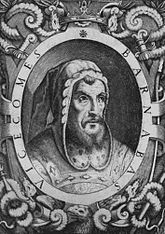
Beatrice Regina della Scala (1331 – 18 June 1384) was an Italian noblewoman, a member of the Scaliger family of Northern Italy. She was the wife of Bernabò Visconti, Lord of Milan, and the mother of his seventeen legitimate children. Beatrice Regina was born in Verona in 1331,[1] the youngest child and only daughter of Mastino II della Scala and Taddea da Carrara. She had three older brothers, and five illegitimate half-siblings. Her father, who was a member of the Scaliger family of Northern Italy, was Lord of Verona, Vicenza, Brescia, Parma, and Lucca.[1] Her paternal grandparents were Alboino I della Scala and Beatrice, daughter of Gilberto III da Correggio of Parma, and her maternal grandparents were Jacopo I da Carrara and Anna Gradenigo, daughter of Pietro Gradenigo, Doge of Venice and Tommasina Morosini.
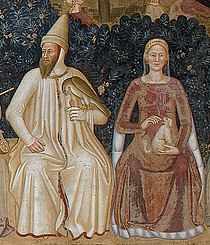
Wartislaw VI of Pomarania (1345 – 13 June 1394) was a member of the House of Griffins. From 1365 to 1377, he ruled Pomerania-Wolgast jointly with his brother Bogislaw VI. From 1377 until his death, he was the sole ruler of Pomerania-Barth.
He was the eldest son of the Duke Barnim IV of Pomerania-Wolgast-Rügen and his wife, Sophie of Werle.
Bogislaw V (Polish: Bogusław, Latin: Bogislaus) (c. 1318 – 23 April 1374) was a Duke of Pomerania.[1]
Eldest son of Duke Wartislaw IV and Elisabeth of Lindow-Ruppin, Bogislaw had two brothers, Barnim IV and Wartislaw V. The brothers were joint rulers from their father's death in 1326. They allied with King Casimir III of Poland, whose daughter Elisabeth married Bogislaw, against the Teutonic Order. Elisabeth died in 1361; in 1362 Bogislaw married Adelheid Welf, daughter of Ernest I, Duke of Brunswick-Grubenhagen.
The death of Barnim in 1366 led to a quarrel between Bogislaw and Wartislaw, which was settled by a treaty in 1368 partitioning Pomerania between Bogislaw V, Wartislaw V, and Barnim's sons, Bogislaw VI and Wartislaw VI. Bogislaw received most of the Farther Pomeranian parts of Pomerania-Wolgast, thence Pomerania-Stolp (named after the town of Stolp, now Słupsk). Wartislaw received the Neustettin (now Szczecinek) area, and the sons of Barnim received North-Western Pomerania with Rügen and Usedom.
Bogislaw's daughter Elisabeth married the Holy Roman Emperor Charles IV, King of Bohemia in 1363 and he concluded an alliance with his son-in-law in 1370.
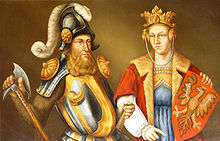
Adelheid of Brunswick-Grubenhagen. She was a daughter of Ernest I, Duke of Brunswick-Grubenhagen and Adelheid of Everstein.
Count Henry II of Holstein-Rendsburg (nickname Iron Henry; c. 1317 – c. 1384) was count of Holstein-Rendsburg and pledge lord of Southern Schleswig. He ruled jointly with his younger brother, Count Nicholas (d. 1397).
Henry was the elder son of Count Gerhard III and Sophia of Werle. Henry was a major European player as a mercenary leader and a typical representative of the late medieval knighthood. He fought in Italy, Russia, Estonia and France. He served in the English and Swedish armies. In 1367, he was commander of a fleet of the Hanseatic League and in 1368, he conquered Copenhagen. Count Henry II and his brother Nicholas vigorously defended their claims in Holstein and Schleswig, against Denmark and against the Frisians.
Ingeborg of Mecklenburg (1343/45[1] – 25 July 1395) was a daughter of Albert II, Duke of Mecklenburg and his wife, Euphemia of Sweden. Euphemia was a daughter of Ingeborg of Norway, who was the only legitimate child of King Haakon V of Norway. Thus, Ingeborg of Mecklenburg was Haakon V's great-granddaughter
Siemowit III of Masovia (his name also rendered Ziemowit; c. 1320 – 1381) was a prince of Masovia and a co-regent (with his brother Casimir I of Warsaw) of the lands of Warsaw, Czersk, Rawa, Gostynin and other parts of Masovia. Siemowit was the second son of Trojden I of Masovia and his wife Maria, daughter of Yuri I of Galicia.

Algirdas (Belarusian: Альгерд', Russian: Ольгерд, Polish: Olgierd, name on his personal seal (Cyrillic Script) Олгер equals toHolger) (c. 1296 – May 1377) was a monarch of medieval Lithuania. He ruled the Lithuanians and Ruthenians from 1345 to 1377. With the help of his brother Kęstutis (who defended the western border of the Duchy) he created an empire stretching from the present Baltic states to the Black Sea and to within fifty miles of Moscow.
Algirdas was one of the seven sons of Grand Prince Gediminas. Before his death in 1341, Gediminas divided his domain, leaving his youngest son Jaunutis in possession of the capital, Vilnius. With the aid of his brother, Kęstutis, Algirdas drove out the incompetent Jaunutis and declared himself Grand Prince in 1345. He devoted the next thirty-two years to the development and expansion of the Grand Duchy of Lithuania.

Uliana Alexandrovna of Tver (Russian: Ульяна Александровна Тверская; c. 1325[1] – 17 March 1391)[2] was a daughter of Prince Alexander of Tver and Anastasia of Halych (daughter of Yuri I of Galicia).
Federico I de Sajonia, el Pendenciero (en alemán Friedrich der Streitbare; Altenburgo, 11 de abril de 1370 - Altenburgo, 4 de junio de 1428) fue margrave de la Marca de Meissen-Lusacia entre 1381 y 1423 como Federico IV, y conde palatino de Sajoniay elector de Sajonia entre 1423 y 1428.
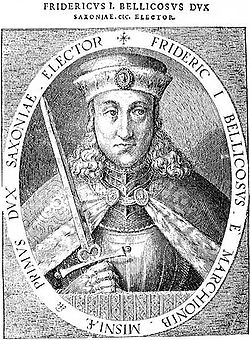
Catalina de Brunswick-Lüneburg (1395 - 28 diciembre 1442, Grimma) era miembro de la Casa de Welf, princesa de Brunswick-Lüneburg y por matrimonio, electora deSajonia.
Catalina era la única hija y el segundo hijo del duque Enrique I de Brunswick-Lüneburg († 1416) de su primer matrimonio con Sofía († junio 1400), hija del Duque Vartislaw VIde Pomerania.
duque de Baviera-Múnich Ernesto y Isabel Visconti, hija de Bernabé Visconti, señor de Milán.
* c. 1380
Elisabeth von Braunschweig-Göttingen
* c. 1390
Conrad I of Oldenburg (German: Konrad I. von Oldenburg; died 1367) was the Count of Oldenburg from 1344 to 1367. He succeeded his brother, John III of Oldenburg.
He was the son of John II of Oldenburg and Hedwig of Diepholz
Count Henry II of Holstein-Rendsburg (nickname Iron Henry; c. 1317 – c. 1384) was count of Holstein-Rendsburg and pledge lord of Southern Schleswig. He ruled jointly with his younger brother, Count Nicholas (d. 1397).
Henry was the elder son of Count Gerhard III and Sophia of Werle. Henry was a major European player as a mercenary leader and a typical representative of the late medieval knighthood. He fought in Italy, Russia, Estonia and France. He served in the English and Swedish armies. In 1367, he was commander of a fleet of the Hanseatic League and in 1368, he conquered Copenhagen. Count Henry II and his brother Nicholas vigorously defended their claims in Holstein and Schleswig, against Denmark and against the Frisians.
Ingeborg of Mecklenburg (1343/45[1] – 25 July 1395) was a daughter of Albert II, Duke of Mecklenburg and his wife, Euphemia of Sweden. Euphemia was a daughter of Ingeborg of Norway, who was the only legitimate child of King Haakon V of Norway. Thus, Ingeborg of Mecklenburg was Haakon V's great-granddaughter.
Magnus (1324–1373), called Magnus with the Necklace (Latin: Magnus Torquatus) or Magnus II, was Duke of Brunswick-Lüneburg, ruling the Brunswick-Lüneburg principalities of Wolfenbüttel (colloquially also called Brunswick) and, temporarily,Lüneburg.
Magnus was the son of Magnus the Pious, Duke of Brunswick-Lüneburg (Wolfenbüttel). In 1362 Magnus and his brother Louis I, Duke of Brunswick-Lüneburg helped their brother Prince-Archbishop Albert II of Bremen to assert himself against the incumbentdiocesan administrator Morris of Oldenburg, who claimed the see for himself. Magnus, Louis and the latter's father-in-law William II, Duke of Brunswick-Lüneburg (Celle), and their troops beleaguered Morris in the prince-archiepiscopal castle in Vörde and forced him to sign his resignation.
Eric II of Saxe-Lauenburg (1318/1320 – 1368) was a son of Duke Eric I of Saxe-Lauenburg and Elisabeth of Pomerania (*1291–after 16 October 1349*), daughter of Bogislaw IV, Duke of Pomerania. Eric II succeeded his father, after his resignation in 1338, as duke of Saxe-Ratzeburg-Lauenburg, a branch duchy of Saxe-Lauenburg.
Agnes of Holstein (died: 1386) was a Countess of Holstein-Kiel by birth and by marriage a Duchess of Saxe-Lauenburg. She was the daughter of Count John III of Holstein-Plön (d. 1359) and Catherine (d. 1327), daughter of Duke Henry III of Silesia-Glogau.
She died in 1386 and was buried in the Cathedral in Ratzeburg.
Frederick III, the Strict (14 December 1332, Dresden – 21 May 1381, Altenburg), Landgrave of Thuringia and Margrave of Meissen, was the son of Frederick II, Margrave of Meissen and Mathilde of Bavaria.

Catherine of Henneberg (German: Katharina von Henneberg ; c. 1334, Schleusingen – 15 July 1397, Meissen) was a Countess of Henneberg by birth and from 1347 by marriage Margravine of Meissen, Landgravine of Thuringia, etc. She was the wife of Margrave Frederick the Severe of Meissen. Via her, the House of Wettin inherited her father's Franconian possessions. Catherine was the second of four daughters of Count Henry IV of Henneberg-Schleusingen and his wife Judith of Brandenburg-Salzwedel.
Henry of Brunswick-Lüneburg (Latin Henricus, died 14 October 1416), Duke of Brunswick-Lüneburg, called Henry the Mild, was prince of Lüneburg from 1388 to 1409 jointly with his brother Bernard I, Duke of Brunswick-Lüneburg, from 1400 to 1409 also of Wolfenbüttel, and from 1409 until his death sole prince of Lüneburg.
Henry was the fourth son of Magnus with the Necklace, Duke of Brunswick-Lüneburg. He participated in the prosecution of the murderers of his brother Frederick, elected King of the Romans, after 1400. Henry ravaged the Eichsfeld, a possession of thearchbishop of Mainz, who was suspected to be involved in the murder. Only in 1405, a peace was ratified between Brunswick-Lüneburg and the Archbishopric.
Sophie (died 1406), daughter of Wartislaw VI, Duke of Pomerania
Barnim VI, Duke of Pomerania (c. 1365 – 22 September 1405 in Pütnitz, near Ribnitz-Damgarten) was duke of Pomerania-Wolgast from 1394 to 1405. He was the son of Wartislaw VI of Pomerania-Wolgast.

Veronica of Hohenzollern
Erich IV. von Sachsen-Lauenburg (* 1354; † 1411) war 1368 bis 1411 Herzog von Sachsen-Lauenburg. Er war der Sohn des Herzogs Erichs II. von Sachsen-Lauenburg und der Agnes von Holstein.
Bogislaw VIII (c. 1364 – 11 February 1418)[1] was Duke of Pomerania in Pomerania-Stolp from 1395 until 1418. Bogislaw V, Duke of Pomerania y Adelheid of Brunswick-Grubenhagen
Sophie of Holstein, the daughter of Henry II, Count of Holstein-Rendsburg


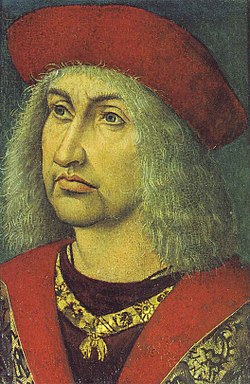

Sophie of Holstein, the daughter of Henry II, Count of Holstein-Rendsburg
Siemowit IV (Ziemowit IV), also known as Siemowit IV the Younger (pl: Siemowit IV Młodszy; ca. 1353/1356[1] – 21 January 1426[2]), was a Polish prince member of the House of Piast from the Masovian branch, from 1373/74 Duke of Rawa, and after the division of the paternal inheritance between him and his brother in 1381, ruler over Rawa, Płock, Sochaczew, Gostynin, Płońsk and Wizna, since 1386 hereditary Polish vassal, since 1388 ruler over Belz, during 1382-1401 he loss Wizna and during 1384-1399 and 1407-1411 he loss Zawkrze, during 1384-1399 he loss Płońsk, taken by the Teutonic Order.
He was the second son of Siemowit III, Duke of Masovia and his first wife Euphemia, daughter of Nicholas II of Opava.
Alexandra (d. 20 April 1434), a Lithuanian princess, daughter of Algirdas, Grand Duke of Lithuania, and his second wife, Uliana of Tver.[
Casimiro di Brandeburgo-Bayreuth (Ansbach, 27 dicembre 1481 – Buda, 21 settembre 1527) fu Margravio di Bayreuth dal 1515 alla propria morte.
Egli era figlio del Margravio Federico I e di sua moglie, la Principessa Sofia di Polonia, figlia del ReCasimiro IV Jagellone.

Susanna di Wittelsbach (Monaco di Baviera, 2 aprile 1502 – Neuburg, 23 aprile 1543) fu una nobilebavarese.
Era figlia di Alberto IV di Baviera, duca di Baviera, e Cunegonda d'Austria. Le venne messo il nome di una sorellina nata nel 1499 e morta ad un anno.

Henry VII of Waldeck (died: after 1442[1]) was Count of Waldeck from 1397 until his death, after which he acted several times asbailiff for the Electorate of Mainz in Upper and Lower Hesse.
Son of the Count Henry VI of Waldeck and Elizabeth of Berg and was considered a belligerent man.
Margaret of Nassau-Wiesbaden-Idstein.
Engelbert I of Nassau (c. 1370–1380, in Dillenburg – 3 May 1442, in Breda) was a son of Count Johan I of Nassau and Countess Margaretha of the Marck, daughter of Count Adolph II of the Marck.
Johanna van Polanen (also spelled as Jehenne; 10 January 1392 – 15 May 1445 in Breda) was a Dutch noblewoman. She was the daughter of John III of Polanen, Lord of Breda, and his wife, Odilia of Salm.
Alberto III de Sajonia-Meissen, (Grimma, 27 de enero de 1443 - Emden, 12 de septiembre de 1500) era un noble alemán, que gobernó en Sajonia-Wittenberg, y que fue llamado Alberto el Osado (en alemán Albrecht der Beherzte).
Fue Margrave de la marca de Meissen (1464-1485), Duque de Sajonia-Meissen (1485-1500) y Estatúder (gobernador) de los Países Bajos (1488-1494).

Sidonia de Bohemia (hija del rey Jorge I de Bohemia
Joaquín Néstor I o Joaquín I Néstor (21 de febrero de 1484 - 11 de julio de 1535) fue un príncipe elector del territorio de Brandeburgo (1499-1535) y miembro de la Dinastía Hohenzollern. Su apodo proviene del Rey Nestor mitología griega.
Joaquín, hijo mayor de Juan Cícero (elector de Brandeburgo), recibió una excelente educación bajo la supervisión de Dietrich von Bulow, Obispo de Lebus y Rector de la Universidad de Frankfurt. Fue nombrado Elector de Brandeburgo después del a muerte de su padre en enero de 1499

Andrei Ivanovich Kobyla (Russian: Андре́й Ива́нович Кобы́ла) was a progenitor of the Romanov dynasty of Russian tsarsand many Russian noble families.
This boyar was documented in contemporary chronicles only once, in 1347, when he was sent by Grand Duke Simeon the Proud to Tver with the purpose of meeting Simeon's bride, who was a daughter of Alexander I of Tver. Neither his pedigree nor exact position at court are known, hence the speculation abounds.
Later generations assigned to Kobyla the most illustrious pedigrees. At first it was claimed that he came to Moscow fromPrussia in 1341, where his father had been a famous rebel. In the late 17th century, a fictional line of his descent from Julius Caesar was published. It's likely that Kobyla's origins were less spectacular. Not only is Kobyla Russian for mare, but his relatives were also nicknamed after horses and other house animals, thus suggesting descent from one of theRatshid[citation needed] royal equerries.
16th-century genealogies mention five of Andrei's sons: Simeon Zherebets, Alexander Yolka, Vasily Vantey, Gavrila Gavsha, and Fyodor Koshka.
Charles I of Baden (1427 – 24 February 1475, Pforzheim) was a Margrave of Baden-Baden during 1454–1475.
Charles was the elder son of Jacob, Margrave of Baden-Baden and his wife Catherine, daughter of Charles II, Duke of Lorraine. In 1462 he became involved in the Bavarian War (1459–63) against Frederick I, Elector Palatine. This war finished in the same year with Charles' defeat and capture at the Battle of Seckenheim.
Catherine of Austria (1424 in Wiener Neustadt – 11 September 1493 at Hohenbaden Castle in Baden-Baden) was a member of the House of Habsburg and through marriage Margravine of Baden.
Catherine was a daughter of the Duke Ernest I of Austria and Styria, nicknamed "the Iron" (1377-1424) from his marriage toCymburgis (1394-1429), a daughter of Duke Siemowit IV of Masovia. Catherine's older brother Frederick III was crowned Holy Roman Emperor in 1452. She grew up in Wiener Neustadt, together with her brothers Frederick III and Albert VI.[1]
Philipp von Katzenelnbogen, graf Hijo de Philipp I der Ältere, Graf von Katzenelnbogen y Anna von Württemberg, Gräfin von KatzenelnbogenOttilie von Nassau-Dillenburg Hija de Hendrik II van Nassau, heer van Loon op Zand y Genoveva von Virneburg
Louis I of Zweibrücken (German: Pfalzgraf Ludwig I. von Pfalz-Zweibrücken "der Schwarze") (1424 – 19 July 1489) was Count Palatine and Duke of Zweibrücken and of Veldenz in 1444–1489.
He was the younger son of Stefan, Count Palatine of Simmern-Zweibrücken and his wife Anna, heiress of the County of Veldenz, whom he had wed in 1409. Although Anne died in 1439, her widower did not obtain Veldenz from her family until 1444. In that year, Stefan decided how his territories would be divided upon his death, allocating Simmern to his elder son, Frederick and Zweibrucken to his younger son Louis, combining with it Veldenz and most of the County of Sponheim.[1]
Count Kraft VI of Hohenlohe-Weikersheim (1452 in Neuenstein – 2 August 1503 in Neuenstein) was canon (priest) in Mainz andSpeyer.
His parents were Kraft V, Count of Hohenlohe-Weikersheim and Margaret of Oettingen.
Helene of Württemberg (died: 19 February 1506), daughter of Count Ulrich V of Württemberg and Margaret of Savoy.
|
No hay comentarios:
Publicar un comentario